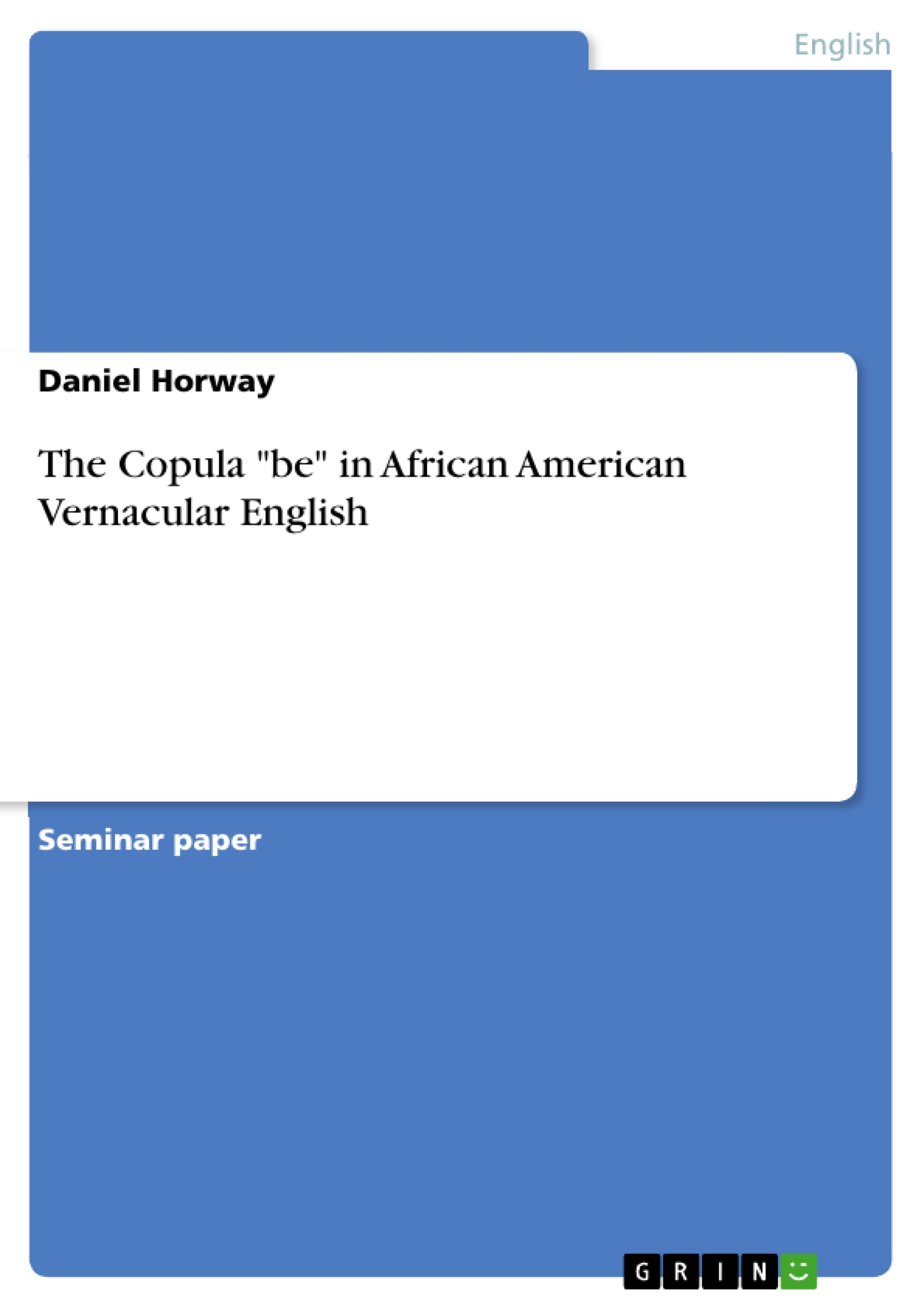The word "be" is the plainest and most basic element in the English language and its varieties. At the same time, it is probably the most essential. This paper will focus on this one essential item only and analyze its copulative functions in African American Vernacular English (AAVE). Within this variety the copula has been one of the most popular and well researched topics for several decades. Its popularity can be traced back to the dispute about the origin of African American English (AAE) itself. In the discussion whether AAE emerged as a creole or developed solely from English, the copula resembles one of the strongest arguments to support the creolists’ hypothesis. Even the opposing dialectologists admit that the copula “cannot be identified as a legacy of English”.
This analysis will be presented in this paper in two steps, a theoretical one as well as a practical one. To begin with, paragraph two will provide a theoretical analysis of the copula and its functions. That includes its basic structure and the different appearances in different syntactic environments. Furthermore, those differences shall be explained consulting a theory by Labov, which eventually will enable us to create a structure on how to analyze copula environments and apply it to a contemporary example in paragraph three.
This part will contain a practical research on the use of the copula during a comedy show by Dave Chappelle, presented on HBO. For that purpose, the findings will be presented, evaluated and compared to other data from the literature already discussed in the theoretical part, including studies on sociolinguistic aspects. This research again will help to draw a conclusion between the findings of recent literature and our own study; highlight similarities and differences and eventually present an accurate picture of the usage of the copula be in AAVE.
The following key questions shall be answered during that process: What are the different functions of the copula? What influences its surface appearance, and how often and to what account are the different forms actually used in spoken language? Those questions will support the understanding of the main purpose of this paper, namely to analyze the use of the different copula forms in different environments with a focus on copula absence.
Table of Contents
- Introduction: The Copula a Crucial Point
- Theoretical Analysis of the Copula be
- Variability in Copula Use
- Exceptions of Copula Absence
- The Invariant be
- Copula Environment
- The Preceding Environment
- The Following Environment
- Explanation of Copula Absence Distribution
- Variability in Copula Use
- Practical Research on Copula Distribution
- Data and Methods
- Presenting Results
- The Three Types of Copula and their Use
- The Preceding Environment
- The Following Environment
- Exceptions of Copula Deletion
- Conclusion
Objectives and Key Themes
This paper aims to analyze the copulative functions of the verb "be" in African American Vernacular English (AAVE). It delves into the historical context of the debate surrounding the origin of AAE, emphasizing the significance of the copula in this discussion. The paper explores both theoretical and practical aspects of copula usage, aiming to understand its structure, variations in syntactic environments, and the factors that influence its presence or absence.
- The significance of the copula "be" in AAVE
- The theoretical analysis of copula variations in syntactic environments
- The influence of phonological and sociolinguistic factors on copula usage
- The distribution of different copula forms in spoken language
- Comparative analysis of copula usage in AAVE and Standard English
Chapter Summaries
The paper begins by introducing the copula "be" as a fundamental element in English and its varieties, particularly AAVE. It then dives into a theoretical analysis of the copula, examining its structure, different forms, and how its variations are explained by Labov's theory.
Chapter 2.1 focuses on the variability of copula use in AAVE, exploring the different forms: the zero copula, the full form, and the contracted form. Labov's research is presented, highlighting the categorical rules that govern copula absence.
Chapter 2.1.1 details specific exceptions to copula absence, particularly in the present tense and the 1st person singular. The chapter also examines the impact of specific sentence structures on copula usage.
Chapter 2.2 delves into the environment surrounding the copula, considering the elements that precede and follow it. This analysis aims to provide a clearer understanding of the factors influencing copula usage.
Chapter 2.3 presents a comprehensive explanation of the distribution of copula absence in AAVE, drawing on insights from the theoretical discussion.
Chapter 3 shifts to practical research, presenting data and methods used to analyze copula distribution. It explores the three main types of copula forms and their use in spoken language.
Chapter 3.2 examines the preceding and following environments of the copula, further clarifying the factors influencing its presence or absence in specific contexts.
Chapter 3.2.4 delves into the specific exceptions of copula deletion in spoken language, providing further insight into the complexities of copula usage.
Keywords
This paper examines the use of the copula "be" in African American Vernacular English (AAVE), focusing on its variability, distribution, and the factors influencing its presence or absence. Key themes include the historical context of AAE development, theoretical analysis of copula structure and function, and practical research on copula usage in spoken language. The study draws on prominent scholars like Labov and Kautzsch, and utilizes insights from sociolinguistics and language acquisition to understand the complexities of the copula in AAVE.
- Quote paper
- Daniel Horway (Author), 2014, The Copula "be" in African American Vernacular English, Munich, GRIN Verlag, https://www.grin.com/document/304601



